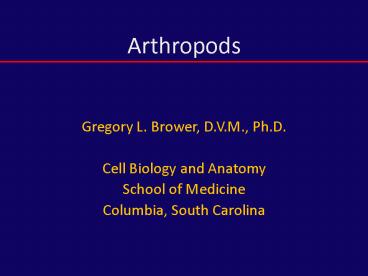Arthropods - PowerPoint PPT Presentation
1 / 28
Title:
Arthropods
Description:
Burial of fly larvae in tissue ... Healthy or necrotic tissue. mandibular hooks aided by proteolytic enzymes. Gastrointestinal ... – PowerPoint PPT presentation
Number of Views:244
Avg rating:3.0/5.0
Title: Arthropods
1
Arthropods
- Gregory L. Brower, D.V.M., Ph.D.
- Cell Biology and Anatomy
- School of Medicine
- Columbia, South Carolina
2
Textbook Is Not Your Best Resource
Textbooks are at least 4 years out of date. Keep
abreast of current treatment regimes by
consulting Centers for Disease Control or World
Health Organization web sites. http//www.dpd.cdc
.gov/dpdx/
CDC or WHO www.afpmb.org/pubs/Field_Guide/field_g
uide.pdf
3
Myiasis
- Burial of fly larvae in tissue
- Cochliomyia (New World Screw worm), Chrysomya
(Old World Screw worm) Calliphora, Oestrus,
Sarcophaga, Gastrophilus - Distributed worldwide
4
Myiasis Distribution
- Distribution worldwide
- Healthy or necrotic tissue
- mandibular hooks aided by proteolytic enzymes
- Gastrointestinal
- Urinary
5
Screw WormGeographic Distribution
Chrysomya bezziana
Cochliomyia hominivorax
Cochliomyia hominivorax
6
Chrysomya bezziana Old World Screw Worm
The Breast Journal Vol. 13 297-301, 2007
7
Myiasis Symptoms
- Tissue damage and necrosis
- Secondary bacterial infections
8
Myiasis Treatment
- Hygiene
- Avoid flies, especially on open wounds
- Debridement of wound
- Antibiotics only if secondary bacterial infection
9
Myiasis
10
Lice
Pediculus humanus capitis (head louse) P. humanus
humanus (body louse) Pthirus pubis (crab
louse) Worldwide distribution
11
Lice Life Cycle
12
Pediculus humanus capitis Head Lice
- Mostly children
- Crowded environment
- Adult (secondarily)
- Rarely affects African Americans
- Moderate to severe itching
- Fever
- Secondary infections
13
Head Lice Old School Treatment
- 1 benzene hexachloride (Kwell)
- 0.2 pyrentins
- 2 pipronyl butoxide
- copper oleate may be as effective and less toxic
than benzene hexachloride - Good hygiene
14
Head Lice Current Treatment
15
Pediculus humanus corporis Body Lice
- Similar to head lice
- Affects all ages
- Associated with bad hygiene
- Dermatitis
- Primary vectors of
- Epidemic typhus
- Louse-borne relapsing fever
- Trench fever
- Treatment similar to head lice
- Cleanliness is preventive
16
Phthirus pubis Pubic Lice
- Commonly referred to as crabs
- Transmitted sexually
- Infest coarse hair in pubic area in adults
- Pubic lice found on the head or eyelashes of
children are indication of potential sexual
exposure or abuse. - Occasionally pubic lice may be spread by close
personal contact or fomite transmission from
clothing, bed linens, and towels that have been
used by an infested person.
17
Phthirus pubis Life Cycle
18
Pubic Lice Diagnosis and Treatment
- Symptoms consist of severe itching of the
infested area - Diagnosed based upon finding lice (difficult to
spot) - Treatment similar to head lice
- 1 permethrin
- mousse containing pyrethrins and piperonyl
butoxide - Lindane in refractory cases
19
Fleas Tunga penetrans
- Most fleas are ectoparasites, with the exception
of Tunga penetrans (sand fleas, chigoe, Jigger,
chique, etc.) - Tropical and subtropical
- Female burrows under the skin, lays eggs and dies
20
Fleas Tunga penetrans Life Cycle
21
Tunga penetrans
- Tissue invasion and erosion
- Usually feet and toes are involved
- Severe pruritis and pain
- Auto-amputation can occur in severe cases
- Treatment consists of removal of fleas
(surgically, if necessary) - Shoes are protective
22
Mites (Sarcoptes scabie)
- Cause of Scabies
- Worldwide distribution
- Typically associated with poor living conditions
23
Mites (Sarcoptes scabie)
- Skin affected includes finger webbing, wrists,
buttocks, interscapular, axilla, female breasts,
genitalia and abdomen. - Mite burrows under the skin and forms tunnels.
- Mite lays eggs in tunnels that hatch into larvae.
- Larvae mature, exit the tunnel and form new
tunnels.
24
Mites (Sarcoptes scabie)
- Diagnosis is based on characteristic rash.
- Application of ink to affected areas and wiping
reveals burrows. - Microscopic examination of skin scraping.
Photos courtesy of CDC and University of Iowa
Hardin Library for the Health Scienceshttp//www.
lib.uiowa.edu/Hardin/md/cdc/3810.html
25
Mites (Sarcoptes scabie)
Crusted scabies occurs predominantly in patients
who are immunocompromised, elderly,
institutionalized, or bedridden.
26
Mites (Sarcoptes scabie)
- Swab lesions with malathion or benzene
hexachloride - Topical steroid should be avoided
- Wash clothes in hot water
27
Chiggers (Trombiculidae)
- Ectoparasites
- Eutrombicula sp.
- Leptotrombidium sp.
- Bites typically occur under tight clothing or on
wrinkled skin - ankles, wrists, thighs, groin and waist
- Feed on digested skin and lymph
- Digestive enzymes cause severe irritation
- occasionally fever
28
Chiggers (Trombiculidae)
- Bite develops allergic response
- Larvae usually already detached
- Intense pruritis
- Secondary bacterial infections
- Local anesthetic to relieve irritation































